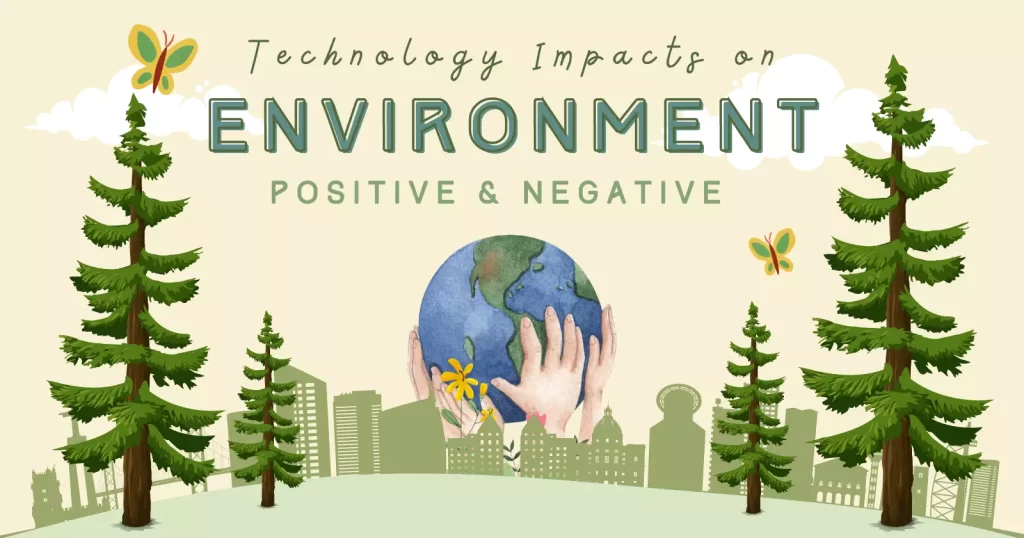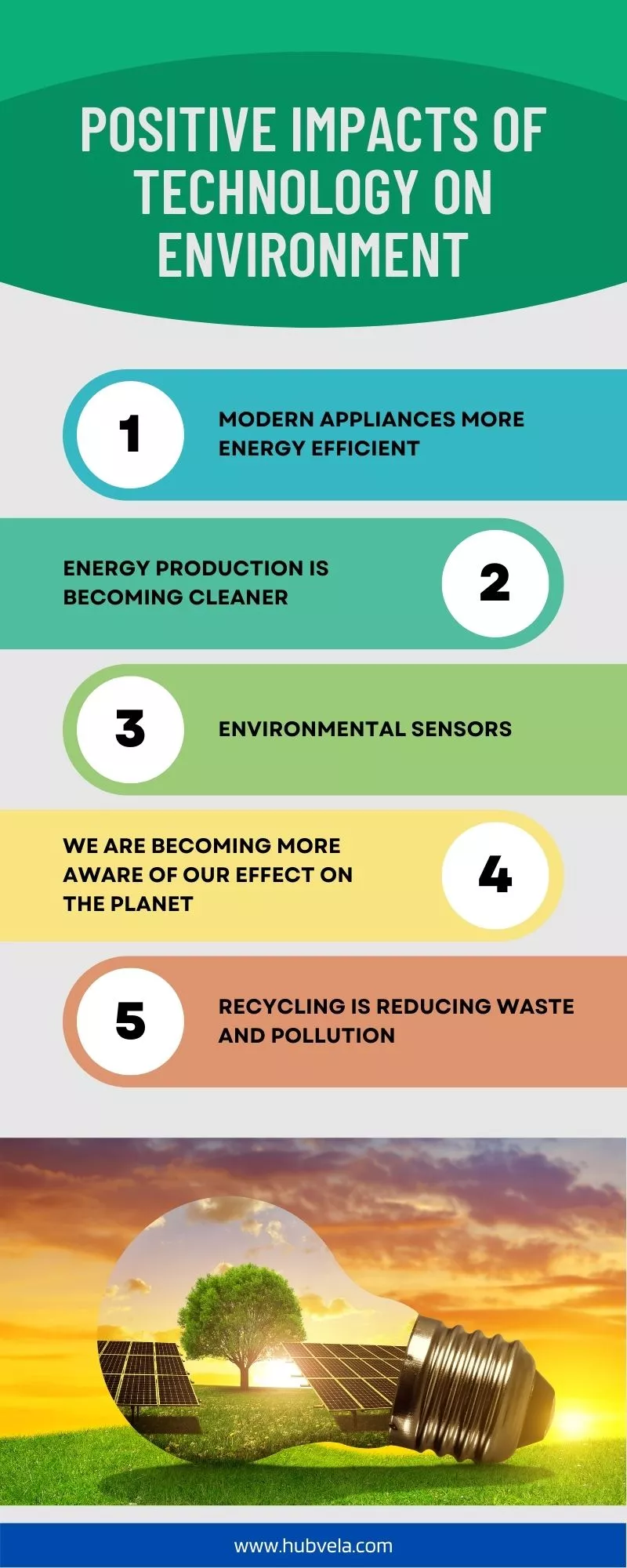Technology’s impact on the environment is a topic of much debate. We will discuss how technology has caused some of the world’s most significant environmental problems, as well as its profound benefits.
This article will explore the positive and negative impacts of technology on environment in detail.

--Advertisement--
Positive Impacts of Technology on Environment
In recent years, there has been a growing focus on the positive impacts of technology on the environment.
The development of environmental technology has led to several innovations that are helping to reduce pollution and conserve natural resources.
This includes advancements in clean energy production, more effective food production systems, and the use of less energy to do things.
In this context, it is important to explore the ways in which technology can be used for good and how it can help us create a more sustainable future.
Let’s discuss the major positive impacts of technology on environment.

1. Modern appliances are more energy efficient
Modern appliances are more energy-efficient, which has a positive impact on the environment. Energy-efficient appliances use less energy to perform the same tasks as older models, which reduces greenhouse gas emissions and helps prevent climate change.
This is because they require less electricity to operate, and electricity from renewable resources such as solar, geothermal, and wind generally does not contribute to climate change or local air pollution.
In addition, using energy-efficient appliances can help reduce overall energy consumption in homes and buildings, which further reduces environmental impact.
Overall, modern appliances that are designed to be more energy-efficient are an important part of the positive impacts of technology on the environment.
2. Energy Production Is Becoming Cleaner
One of the positive impacts of technology on the environment is that energy production is becoming cleaner.
Renewable energy sources such as solar, geothermal, and wind do not contribute to climate change or local air pollution.
Electric vehicles are another example of how technology can have a positive impact on the environment by reducing carbon emissions.
Clean energy technology is an important tool for ensuring clean energy substitution.
Renewable energy sources emit little to no greenhouse gases and are often cheaper than traditional fossil fuels.
Overall, advancements in technology are helping to reduce the negative impact of human activities on the environment.
3. Environmental Sensors
Environmental sensors are a technology that has a positive impact on the environment. They play a vital role in monitoring and reducing pollution levels, identifying sources of pollution, and tracking the quality of air and water.
Remote sensing technologies also help in planning, monitoring, and evaluating the impact on the ground.
By using sensors to monitor endangered species or generating renewable energy, technology is helping us save the environment.
Therefore, environmental sensors are an essential tool for environmental protection and conservation.
4. Conservation and Preservation of Natural Resources
Technology can be used to conserve and preserve natural resources. Environmental technology aims to reduce the impact of technology on Earth.
Technology can help us save the planet by developing renewable energy sources, which is one of the most significant ways to contribute to saving the environment.
Careful planning and regulation of technological systems can protect shared resources such as oceans, fresh water, and air.
Additionally, technology can help monitor and reduce environmental pollution. For example, sensors can detect pollutants in the air or water and alert authorities to take action.
Overall, technology has great potential to positively impact conservation and preservation efforts for natural resources.
5. Recycling Is Reducing Waste And Pollution
Recycling is one of the positive impacts of technology on the environment. It reduces waste and pollution by converting waste materials into new materials and objects.
Recycling also helps reduce greenhouse gas emissions by reducing energy consumption. In addition, recycling e-waste saves space in landfills and prevents environmental pollution caused by toxins.
By reducing the amount of waste sent to landfills and combustion facilities, recycling conserves natural resources such as water, minerals, and timber.
Therefore, recycling is an important way to reduce waste and pollution while conserving natural resources.
Negative Impacts of Technology on Environment
Technology has brought about many positive changes in our lives, but it has also had negative impacts on the environment.
The advancement of technology has led to faster consumption of fossil fuels, contamination of natural resources, deforestation, and resource depletion.
Air pollution, water pollution, and noise pollution are some of the key components that have been continually polluted as a result of technology.
In this context, it is important to understand the negative impacts of technology on the environment.

1. E-waste and Toxic Materials
Electronic waste, or e-waste, contains toxic components such as mercury, lead, cadmium, and polybrominated flame retardants that are dangerous to human health.
E-waste is not biodegradable and accumulates in the environment, including soil, air, water, and living things.
Improper handling of used electronics and e-waste can result in harm to human health. Children exposed to e-waste are particularly vulnerable to the toxic chemicals they contain due to their smaller size and less developed organs.
Recycling e-waste helps save space in landfills and prevents environmental pollution caused by toxins.
2. Greenhouse effects and depletion of the ozone layer
The negative impacts of technology on the environment include greenhouse effects and depletion of the ozone layer.
The depletion of the ozone layer is linked to the presence of chlorofluorocarbons (CFCs) and other halogen-source gases in the atmosphere.
Ozone layer depletion increases the amount of UVB that reaches the Earth’s surface, which can have harmful effects on human health and wildlife.
A quantitative study found that plastic bag manufacturing contributes to ozone layer depletion, which has potential environmental impacts.
Additionally, observations show that as greenhouse gases increase, it creates conditions that lead to ozone loss.
Therefore, it is important for technology to be developed in a way that minimizes its negative impact on the environment.
3. Deforestation at an excessive rate
Technology has led to resource depletion, which refers to the consumption of resources faster than they can be replenished.
Mining, which is a result of technological advancements, is responsible for deforestation, landscape degradation, water pollution, and the release of vast quantities of carbon dioxide.
Deforestation has a broader impact on global climate and biodiversity.
It exacerbates global warming and wipes out biodiversity. Agriculture, which is poorly planned and unsustainable, is the main cause of deforestation.
Therefore, it is important to use technology in a sustainable way that does not harm the environment.
4. Massive Energy Use & Carbon Footprint
One of the negative impacts of technology on the environment is massive energy use and carbon footprint.
The manufacturing process of electronic and technological products requires a significant amount of energy, which contributes to carbon emissions.
This has led to an increase in greenhouse gases, which contribute to climate change. However, renewable resources such as solar, geothermal, and wind can help reduce the carbon footprint of energy production.
To combat this issue, companies and countries are exploring options to become carbon negative by removing more CO2 from the atmosphere than they emit.
It is important for individuals and organizations to be aware of their energy consumption and take steps toward reducing their carbon footprint.
5. An increase in pollution
The production and use of technology can cause air, water, heat, and noise pollution. The depletion of natural resources caused by technology also contributes to environmental pollution.
Technology misuse and wrong implementation can lead to environmental pollution. However, technology can also be used to reduce pollution.
For example, technological advancements have made it possible to reduce vehicular emissions of volatile organic compounds (VOCs).
Therefore, it is important to consider both the positive and negative impacts of technology on the environment.
Conclusion on the Positive and Negative Impacts of Technology on Environment
The impact of technology on the environment is a complex issue with both positive and negative effects. While some argue that technology has caused environmental problems such as pollution and climate change, others point out that technology can also be used to mitigate these issues.
For example, technological advancements in renewable energy have helped reduce reliance on fossil fuels and decrease carbon emissions.
Additionally, technology has enabled more efficient waste management and recycling processes.
Overall, it is important to recognize both the positive and negative impacts of technology on the environment in order to make informed decisions about how to use it responsibly for a sustainable future.


